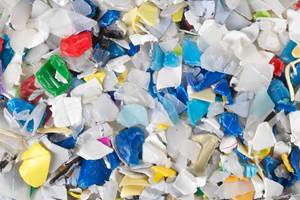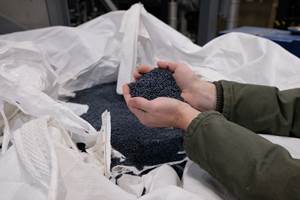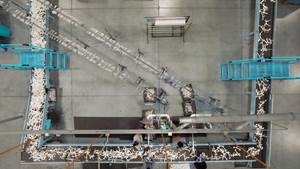Can’t Sell Your New Recycling Concept?
Put It into Production Yourself!
Salyp N.V. in Ypres, Belgium, developed a dry mechanical sorting process for auto shredder residue over the past eight years. The R&D firm built a full-size plant in hopes of selling it to a scrap dealer but found no takers. Owner Omer Saelens and other company managers decided they had no choice but to operate the plant themselves.
Saelens and his colleagues—consisting only of managers and engineers—transformed themselves from inventors and entrepreneurs into full-time day-shift plant operators. They perform all the manual labor of feeding in loads of shredder waste and unloading batches of separated materials. And like any other crew of operators the world over, when things are running smoothly, they catch a quick game of poker at lunch.
Maverick approach
To the extent that there is any conventional wisdom in recycling auto shredder residue (there’s only one other commercial ASR recycler in the world—Galloo Plastics in neighboring Halluin, Belgium), it is that ASR requires some form of wet separation in altered-density media. Salyp ignores this “rule”: It uses no water except for a secondary step to wash urethane foam so that it can be reused in carpet backing. Salyp’s dry mechanical separation process doesn’t yield pure product, but “product-enriched” streams—copper-rich, iron-rich, plastic-rich, and fiber-rich—all of which have steady markets. Salyp did develop a heat-based resin-separation unit that can produce pure plastic streams, but it sits idle. Instead, Salyp sells its mixed plastics to recyclers who separate and compound it themselves.
Salyp’s technology converts ASR into seven fractions: 3% clean PUR foam, 10% iron-rich material, 9% copper-rich (including other nonferrous metals and glass), 44% organic and fiber materials for fuel, 2% wood for fuel, and 18% mixed plastics. That amounts to 86% by weight recoverable products plus 14% dust and leftover waste that is landfilled.
The process starts with a trommel—a cylindrical, revolving screen—that separates ASR particles into three sizes: 0 to 12 mm (metal and glass), 12 to 50 mm (plastics and fibers), and larger pieces of foam and plastic.
Foam passes on a conveyor belt through a metal separator and then is sorted from rigid plastics with a mechanical device developed by Salyp with Central Material Handling Systems in Groveland, Ill. This device compresses the foam between two rollers turning at different speeds. As foam is released, it springs back and bounces up, allowing it to be blown off the belt. That compression and release also loosen dirt in the foam, enhancing the effectiveness of a subsequent wet washing process developed by Argonne National Laboratory, Argonne, Ill.
The 0-to-12 mm fraction travels past magnets to remove ferrous metals. It then goes through Dry Gravity Separation, a technique from Fren Erschiessungs-u. Bergbau in Leoben, Austria. It combines vibration and air to separate by density.
The 12-to-50 mm fraction starts with mechanical “defibering” equipment developed by Salyp to separate fibers from rigid plastics. The fiber-rich fraction (still containing some plastic) is ground and goes through a second Fren DGS separator to remove the fibers, which are sold for fuel, from the plastic, which is sieved to remove any copper.
Meanwhile the plastic-rich stream from the 12-to-50 mm fraction is shredded and further separated into ferrous metals, non-ferrous metals, a wood-rich fraction that is removed by color sorting (it’s brown), and a plastic-rich stream. All four fractions are recovered.
Innovation into cash
Engineers and managers at Salyp man the machines one shift, five days a week. They process 50 tons a day of ASR and are hiring more operators, so that in June it will move up to five-day/24-hr operation.
Salyp is paid by auto shredders to take the ASR, just like a landfill. Fees are high in Europe, so the equipment paid for itself in less than a year. In the U.S., payback might take two years.
Salyp still wants to sell its machinery to other reclaimers. It just sold its first license for ASR recycling technology to a leading Italian waste handler. It is expected to be operational next year.
Related Content
Looking to Run PCR on a Single Screw? Here’s What to Keep in Mind
Just drop it in and mix it up? Sorry, there’s a lot more to it than that. Here is some of what you need to consider.
Read MoreFoam-Core Multilayer Blow Molding: How It’s Done
Learn here how to take advantage of new lightweighting and recycle utilization opportunities in consumer packaging, thanks to a collaboration of leaders in microcellular foaming and multilayer head design.
Read MoreNew Facility Refreshes Post-Consumer PP by Washing Out Additives, Contaminants
PureCycle prepares to scale up its novel solvent recycling approach as new facility nears completion.
Read MoreReversing Logistics for Plastic Film Recycling
Learn how Mainetti built a circular supply chain for clear film packaging.
Read MoreRead Next
For PLASTICS' CEO Seaholm, NPE to Shine Light on Sustainability Successes
With advocacy, communication and sustainability as three main pillars, Seaholm leads a trade association to NPE that ‘is more active today than we have ever been.’
Read MoreMaking the Circular Economy a Reality
Driven by brand owner demands and new worldwide legislation, the entire supply chain is working toward the shift to circularity, with some evidence the circular economy has already begun.
Read More












 (2).jpg;maxWidth=300;quality=90)










